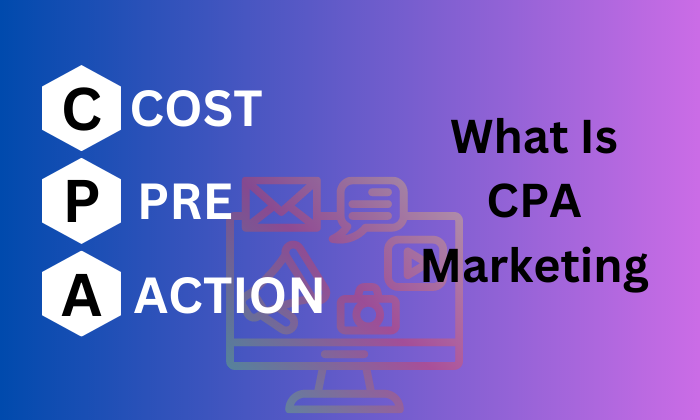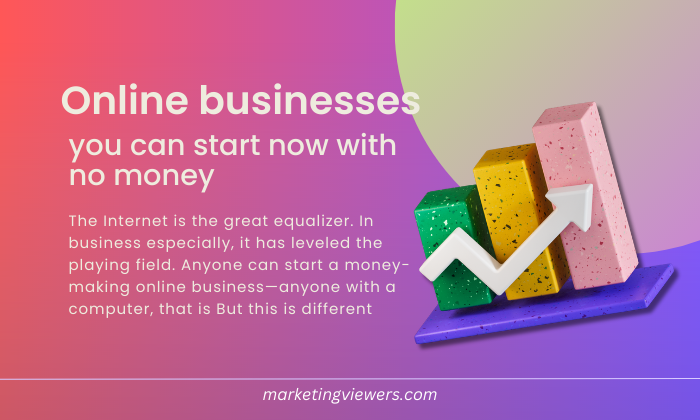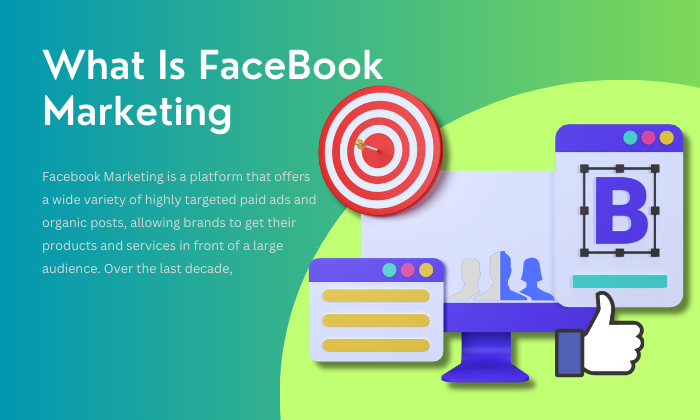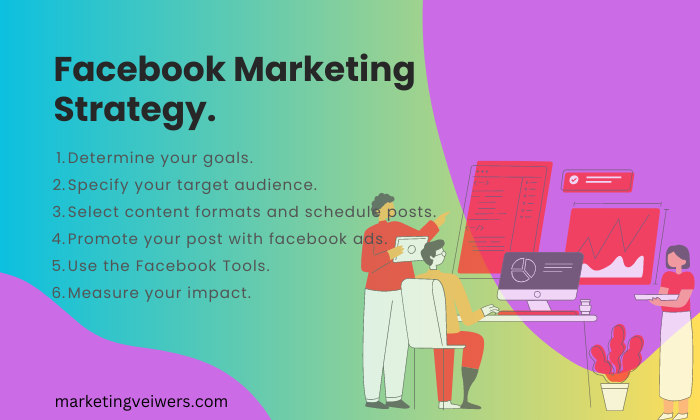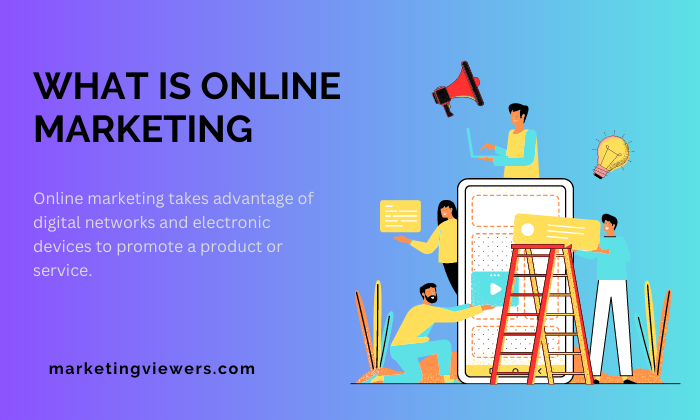Today online is used for everything communication, learning, entertainment, shopping, and more.
Also, there are currently 4.33 billion online users worldwide and the number is growing every second.
For marketers, this offers an incredible opportunity. Never before could an individual reach so many people, in so many ways, so quickly, so easily.

In this article, you’ll learn all about the seven types of online marketing so you can start using them to achieve business success.
What Is Online Marketing?
online (also referred to as online marketing, e-marketing, or web marketing) is an umbrella term used to describe marketing activities conducted online. For this reason, online marketing encompasses a wide range of tactics and strategies, such as social media marketing, content marketing, pay-per-click, and search engine optimization.
What’s the difference between online Marketing and Digital Marketing?
While marketers often use these terms interchangeably, there are subtle differences between online marketing and digital marketing. Basically, digital marketing is a broad term for marketing strategies that take advantage of digital channels to promote products or services, from TV ads and billboards to social media platforms and pay-per-click campaigns. . . It turns out that digital marketing is not just limited to the online
In contrast, online marketing refers to a set of marketing strategies that are exclusively carried out through This makes it a subset of digital marketing, but it’s really a fundamental element, as most digital marketing strategies fall within the boundaries of online-marketing.
- 10 Best Credit Cards for Small Businesses In 2024
- 10 Best Digital Marketing Books for Business Success
- 10 Best Free AI Tools for Digital Marketing In 2024
How Much Types of Online Marketing.
There are 7 types of online marketing:
- Social Media Marketing
- search engine optimization (SEO)
- Content marketing
- Influencer marketing
- Affiliate Marketing
- Email Marketing
- Paid Advertisement
Each of these seven types of online marketing consists of many different tactics and strategies. Also, these types of online marketing complement each other and are often used together.
Let’s explore the various types of online marketing to understand how they work individually and together.
1. Social Media Marketing.
Social media marketing is the process of gaining attention and sales through the use of social media platforms like Facebook, Instagram, or Twitter.
Social media marketing can be split into two camps: organic (free) or paid. Organic social media marketing. Organic social media marketing focuses on building a community and deepening relationships with customers in order to attract interest and customer loyalty. There are numerous ways to do this let’s take a look at a few.
First of all, you can position your brand as an authority in your niche. An easy way to do this is to include other people and provide valuable insight into the conversation. Another important aspect of social media marketing is leveraging the power of customer relationships.
Responding to customer questions quickly on social media demonstrates your brand’s authenticity and will encourage others to trust your product or service. What’s more, social media marketing is closely related to content marketing (which we’ll cover further). That’s because social media platforms are the perfect place to promote valuable content to your community and niche.
OK, but what about social media advertising?
Paid Social Media Marketing There are lots of ways to use paid social media marketing to promote your business, and each platform has its own set of paid promotional options.
Take Facebook.
You can pay to promote your existing organic posts or create a Facebook ad tailored to your marketing objectives. Most paid social media marketing is also called “pay-per-click” (which we will cover in more detail below).
To learn more, check out How to Build a Killer Social Media Marketing Plan.
2. Search engine optimization (SEO).
Search engine optimization also known as SEO is the process of optimizing websites and digital content to improve search engine rankings and, in turn, the number of visitors to a particular webpage. is increased.
In other words, say you want your office furniture website to appear at the top of Google search results whenever someone searches for “office furniture in London”. Well, the process you would use to do this is SEO.
It’s worth noting that today when we talk about SEO we almost exclusively refer to Google (unless you live in China and use the search engine Baidu) Because Google is undoubtedly the world’s most popular search engine eating up 79.77 percent of the market.
So How Does SEO Work?
Search engines use something called “crawler bots” to crawl the web and index content available online.
Then, every time someone searches for a keyword, the search engine will try to provide the most useful and relevant results. SEO has two aspects: on-page and off-page.
What is on page SEO?
On-page SEO is when you optimize your website or content for targeted keywords or phrases to rank high in search engines.
On-page SEO examples include:
Boost your website speed
Having a responsive mobile-optimized web design
including your target keywords
Structure of content with title tags
Optimizing for Google featured snippets
Use of structured data markup
Including internal links from other pages on your website
Adding Outbound Links to Other Related Websites
For this reason, SEO is closely related to content marketing we’ll explore this more below.
What is off-page SEO?
Off-page SEO is when you optimize your website or content to show up higher in search results through methods outside of your website or content. These include external signals like your social media presence and brand mentions.
However, the biggest and most impactful part of off-page SEO is backlink generation. This is when other websites link to your website or content.
The logic behind backlinks is simple.
If a lot of websites link to your website, Google will assume that you have valuable and relevant content. Search engines also consider the authority of the website that links to you. For example, a link from an authoritative website such as the New York Times will be more effective than 100 links from unknown websites.
One of the best ways to build backlinks from authoritative websites is to produce high-quality content that others will want to share. Alternatively, you can create content dedicated to another website this is called “guest posting.”
3. Content marketing
Content marketing is the process of consistently creating, distributing, and promoting relevant online content that is strategically designed to attract, engage, and convert your target market into consumers. .
There are numerous forms of content that businesses use to do this, including:
- Blog Posts
- Videos (often shared on social media platforms like Facebook and YouTube)
- Industry Reports & Studies
- Infographics Summaries of Reports and Studies
- E-books
- Podcast
- The case studies
- E-mails
- The webinars
- This article you are reading is about content marketing!
Content marketing works hand-in-hand with many other types of online marketing especially social media marketing and SEO.
As we saw above, social media is one of the main channels used to distribute and promote content.
Now, let’s take a deeper look at how content marketing is related to SEO. Search engine-optimized content is a great way to increase brand awareness and appear more in search engine results pages (SERPs).
For example, I wrote a blog post titled Instagram Story Dimensions and Killer Ideas to Up Your Game , and I used SEO best practices to optimize it for the keyword “Instagram Story Dimensions.”
And right now, whenever someone searches for that keyword on Google, my article is the top result.
The objective of the game is:
Ideally, most people who search for “Instagram story dimensions” will click on my article and get a lot of value from it. Then, they can explore some of the other great content our website has to offer.
Hopefully, a large percentage of these visitors will sign up to our email list to hear about great new content.
It’s a win.
Our readers get great free content to help them start and grow a business, and we’re the platform that helps them.
The key to content marketing is all about giving before you receive.
To learn more, check out How to use content marketing to attract customers.
4. Inspirational Marketing.
First things first: What is an influencer?
An influencer is someone with a relatively large following online, including:
Mainstream celebrities such as Emma Watson
Celebrities like world chess champion Magnus Carlsen
Micro-influencers (those with less than 100,000 followers) like environmentalist Elizabeth Koss
So What Is Influencer Marketing?
Influencer marketing is the practice of working with influencers to promote a product or service to their online following.
Let us see an example of viral proteins. This food supplements brand partners with influencers to reach their target audience of young, fashionable, health-conscious women.
Here, the inspiring Meredith Foster promotes Vital Proteins on her Instagram account.
Before online marketing, influencer marketing was only available to big brands who could afford to work with big-name celebrities.
But now, anyone can engage in influencer marketing.
In fact, InfluencerMarketingHub found that, on average, micro-influencers with between 10,000 and 50,000 followers charge between $100 and $500 per Instagram post.
Remember, this is an average that is, some people may only charge $50, and many others will happily promote your product in exchange for a free sample.
Alternatively, many businesses will choose to pay the influencer a cut of the sales they produce this is called affiliate marketing (which we’ll cover in the next section).
Want to learn the best part?
Micro-influencers actually perform better than big-name celebrities. This is because most consumers are likely to purchase a product recommended by someone they can relate to.
To learn more, see How to do influencer marketing.
5. Affiliate marketing.
Affiliate marketing is basically just referral marketing online.
A business will set up a program that pays external websites or individuals a commission for the traffic or sales they generate.
Let us see an example.
Website host and domain registrar Bluehost has a popular affiliate marketing program that allows influencers and online marketers to make money promoting their services. Popular blog The Minimalists promotes its Bluehost affiliate link in its articles. Every time one of its readers clicks on a link and signs up, Bluehost gives The Minimalists a piece of the proceeds.
Understandably, affiliate marketing is deeply connected with social media marketing, content marketing, and influencer marketing. This is because most of the affiliate links are promoted in the content or by social media influencers. To get started with affiliate marketing, check out Affiliate Programs: 8 Best Options for Beginners.
6. E-mail marketing
Email marketing is the process of using email to send direct marketing messages to people in an effort to gain new customers and retain existing customers.
Although email marketing may not seem like the most glamorous form of online marketing, don’t underestimate its raw power.
So How Does Email Marketing Work?
Well, before you can start email marketing, you have to get your hands on some email addresses!
For this reason, email marketing almost always works in partnership with other types of online marketing, such as social media marketing and content marketing. In fact, just look on the right hand side of this page and you’ll see a box inviting you to subscribe to our newsletter.
Email marketing campaigns often begin with something called a lead magnet which is just a fancy way of saying “bait.”
Bait is usually a discount coupon or a particularly desirable piece of content, like an e-book. Ashwood offers visitors 10% off their first purchase if they sign up:
Now, this is when the fun starts. Once you’ve captured email addresses, you can start nurturing your email subscribers with useful content, giveaways, discounts, early access to new products, and more.
You can also boost sales using email segmentation. This happens when you create distinct groups of subscribers (called “segments”) based on their personal preferences and what stage each subscriber is at in the buyer’s journey.
Then, you can create automated email campaigns for each segment which:
- Welcome to new subscribers!
- Follow abandoned cars.
- Follow up with new customers to sell again.
- Ask for reviews from happy customers.
- Add inactive subscribers again.
- Collect valuable feedback from current customers.
- To learn more, see 6 Essential Email Templates Every Online Business Should Steal
7. PAID ADVERTISING.
Paid advertising is a type of online marketing strategy where advertisers pay to have their ads displayed on search engines and other online platforms, such as Facebook, YouTube, LinkedIn and Instagram. Paid advertising is often referred to as pay-per-click or PPC this means that advertisers will pay a fee each time a user clicks on one of their ads.
Many platforms now charge advertisers in different ways depending on their marketing objectives, such as:
Cost-per-thousand impressions (also known as cost-per-mile or CPM). This means you’ll be charged every time your ad gets 1,000 views.
Cost Per View (CPV) This means that you will be charged for every view that your video receives.
Cost-per-action (CPA) (also known as cost-per-acquisition). This means that you will be charged every time a user takes a certain action or converts to a user.
Two of the biggest digital advertising platforms are Google and Facebook. Between them, they receive the majority of US digital advertising spending, with 38% and 19%, respectively.
Let’s have a quick look at each of them.

